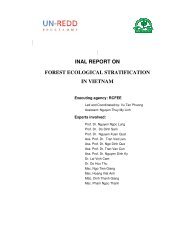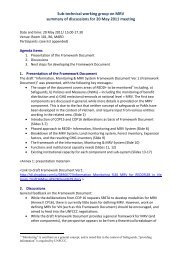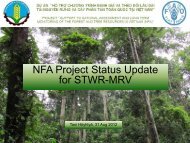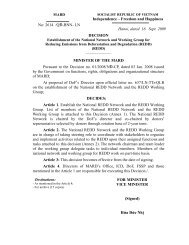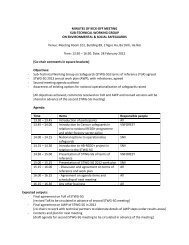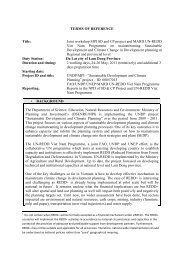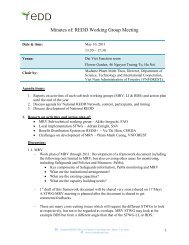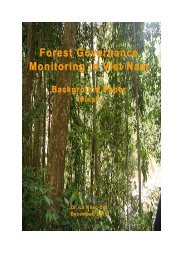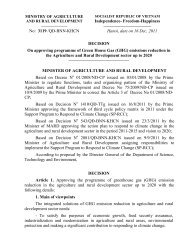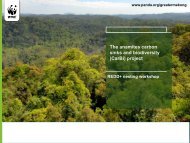Mapping the potential for REDD+ to deliver ... - REDD - VietNam
Mapping the potential for REDD+ to deliver ... - REDD - VietNam
Mapping the potential for REDD+ to deliver ... - REDD - VietNam
Create successful ePaper yourself
Turn your PDF publications into a flip-book with our unique Google optimized e-Paper software.
<strong>Mapping</strong> <strong>the</strong> <strong>potential</strong> <strong>for</strong><strong><strong>REDD</strong>+</strong> <strong>to</strong> <strong>deliver</strong> biodiversityconservation in Viet NamA preliminary analysis
UNEP World Conservation Moni<strong>to</strong>ring Centre219 Huntingdon RoadCambridge, CB3 0DLUnited KingdomTel: +44 (0) 1223 277314Fax: +44 (0) 1223 277136Email: info@unep-wcmc.orgWebsite: www.unep-wcmc.orgSNV <strong><strong>REDD</strong>+</strong> Headquarters5th Floor, Thien Son Building5 Nguyen Gia Thieu, District 3Ho Chi Minh City, VietnamTel: +84 8 39300668Fax: +84 8 39300668Email: rmcnally@snvworld.org or akager@snvworld.orgWebsite: www.snvword.org/reddThe United Nations Environment Programme World Conservation Moni<strong>to</strong>ring Centre (UNEP-WCMC) is <strong>the</strong> specialist biodiversity assessment centre of <strong>the</strong>United Nations Environment Programme (UNEP), <strong>the</strong> world’s <strong>for</strong>emost intergovernmental environmental organisation. The Centre has been in operation <strong>for</strong>over 30 years, combining scientific research with practical policy advice.The SNV <strong><strong>REDD</strong>+</strong> programme has been established in 2009 and identified three main intervention areas necessary <strong>to</strong> make <strong><strong>REDD</strong>+</strong> work, while supporting <strong>the</strong>poor and enhancing biodiversity. The SNV <strong><strong>REDD</strong>+</strong> team of experts pilot interventions in <strong>the</strong>se areas in selected countries across Asia and Africa.This publication may be reproduced <strong>for</strong> educational or non-profit purposes without special permission, provided acknowledgement <strong>to</strong> <strong>the</strong> source is made. Reuseof any figures is subject <strong>to</strong> permission from <strong>the</strong> original rights holders. No use of this publication may be made <strong>for</strong> resale or any o<strong>the</strong>r commercial purpose withoutpermission in writing from UNEP. Applications <strong>for</strong> permission, with a statement of purpose and extent of reproduction, should be sent <strong>to</strong> <strong>the</strong> Direc<strong>to</strong>r, UNEP-WCMC, 219 Huntingdon Road, Cambridge, CB3 0DL, UK.ACKNOWLEDGEMENTSThe mapping work summarized in this report was commissioned by SNV – The Ne<strong>the</strong>rlands Development Organisation as part of <strong>the</strong> project ‘Exploring Mechanisms<strong>to</strong> Promote High-Biodiversity <strong><strong>REDD</strong>+</strong>: Piloting in Viet Nam’. UNEP-WCMC’s contribution <strong>to</strong> <strong>the</strong> project is part of <strong>the</strong> <strong>REDD</strong>-PAC project. Both projects are part of<strong>the</strong> International Climate Initiative. The Federal Ministry <strong>for</strong> <strong>the</strong> Environment, Nature Conservation and Nuclear Safety supports this initiative on <strong>the</strong> basis of adecision adopted by <strong>the</strong> German Bundestag.Preliminary spatial analyses were conducted by Green Field Consulting and Development Co., Ltd. in association with <strong>the</strong> Research Centre <strong>for</strong> Forest Ecology andEnvironment (RCFEE), who were responsible <strong>for</strong> <strong>for</strong>est biomass carbon estimates. Key Biodiversity Area (KBA) and conservation corridor datasets were providedby Conservation International.Thanks <strong>to</strong> Akiko Inoguchi of <strong>the</strong> Food and Agriculture Organization of <strong>the</strong> United Nations (FAO), Florian Werner of Deutsche Gesellschaft für InternationaleZusammenarbeit (GIZ) and Benktesh Sharma who provided comments on a draft version of <strong>the</strong> report.DISCLAIMERThe contents of this report do not necessarily reflect <strong>the</strong> views or policies of UNEP, contribu<strong>to</strong>ry organisations or edi<strong>to</strong>rs. The designations employed and <strong>the</strong>presentations of material in this report do not imply <strong>the</strong> expression of any opinion whatsoever on <strong>the</strong> part of UNEP or contribu<strong>to</strong>ry organisations, edi<strong>to</strong>rs orpublishers concerning <strong>the</strong> legal status of any country, terri<strong>to</strong>ry, city area or its authorities, or concerning <strong>the</strong> delimitation of its frontiers or boundaries or <strong>the</strong>designation of its name, frontiers or boundaries. The mention of a commercial entity or product in this publication does not imply endorsement by UNEP.The maps presented here were produced using publicly available global and national datasets. As such, <strong>the</strong>se maps and this report do not present any officialassessment or statement on Viet Nam’s <strong>for</strong>est biomass carbon, or <strong>the</strong> multiple benefit <strong>potential</strong> of <strong><strong>REDD</strong>+</strong>, on <strong>the</strong> part of <strong>the</strong> Government of Viet Nam or any o<strong>the</strong>rentity. The spatial analysis reported herein was conducted as a demonstration exercise, and <strong>the</strong> resultant maps are <strong>for</strong> illustrative purposes only, with a view <strong>to</strong>stimulating fur<strong>the</strong>r mapping work <strong>for</strong> <strong><strong>REDD</strong>+</strong> planning applications in Viet Nam. The example maps presented here are not intended <strong>to</strong> promote any particularprocess or approach <strong>to</strong> <strong><strong>REDD</strong>+</strong> planning in Viet Nam.CONTRIBUTORSHoang Viet Anh and Le Viet Thanh (email: anh.hv@gfd.com.vn), Green Field Consulting & Development, 27 Ly Thai To Hoan Kiem, Hanoi, Viet NamVu Tan Phuong (email: phuong.vt@rcfee.org.vn), Research Centre <strong>for</strong> Forest Ecology & Environment, Viet Nam Forest Science InstituteVo Thanh Son (email: thanhson.vo@gmail.com), Centre <strong>for</strong> Natural Resources & Environmental Studies, Viet Nam National University University, 144 Xuan ThuyStreet, Cau Giay, Hanoi, Viet NamSteven Swan (email: sswan@snvworld.org), SNV <strong><strong>REDD</strong>+</strong> Headquarters, 5th Floor, Thien Son Building, 5 Nguyen Gia Thieu, District 3, Ho Chi Minh City, Viet NamRebecca Mant, Monika Bertzky, Corinna Ravilious, Julia Thorley, Kate Trumper and Lera Miles (email: climate@unep-wcmc.org)UNEP World Conservation Moni<strong>to</strong>ring Centre, 219 Huntingdon Road, Cambridge, CB3 0DL, UKCITATIONMant, R., Swan. S., Anh, H.V., Phuong, V.T., Thanh, L.V., Son, V.T., Bertzky, M., Ravilious,C., Thorley, J., Trumper, K., Miles, L. (2013) <strong>Mapping</strong> <strong>the</strong> <strong>potential</strong> <strong>for</strong> <strong><strong>REDD</strong>+</strong> <strong>to</strong> <strong>deliver</strong>biodiversity conservation in Viet Nam: a preliminary analysis. Prepared by UNEP-WCMC, Cambridge, UK; and SNV, Ho Chi Minh City, Viet Nam.Available online at: www.carbon-biodiversity.net andwww.snvworld.org/reddPho<strong>to</strong>s: Front and back cover:Left: © iS<strong>to</strong>ckCentre: Loepa sikkima- © Jeremy Holden - SNVRight: Map of vegetation continuous fields de<strong>for</strong>estation rates and <strong>for</strong>est biomasscarbon © UNEP - WCMCUNEP promotesenvironmentally sound practicesglobally and in its own activities.This publication is designed <strong>for</strong> electronicdistribution. Our printing anddistribution policy aims <strong>to</strong> reduceUNEP’s carbon footprint.© 2013 United Nations Environment Programme
<strong>Mapping</strong> <strong>the</strong> <strong>potential</strong> <strong>for</strong><strong><strong>REDD</strong>+</strong> <strong>to</strong> <strong>deliver</strong> biodiversityconservation in Viet NamA preliminary analysisRebecca Mant, Steven Swan, Hoang Viet Anh, Vu Tan Phuong, Le Viet Thanh,Vo Thanh Son, Monika Bertzky, Corinna Ravilious, Julia Thorley, Kate Trumperand Lera Miles
Contents1. Introduction....................................................................................................................... 11.1 <strong><strong>REDD</strong>+</strong>: opportunities and risks <strong>for</strong> biodiversity............................................................ 11.2 <strong>Mapping</strong> and <strong><strong>REDD</strong>+</strong> planning...................................................................................... 21.3 <strong><strong>REDD</strong>+</strong> readiness ef<strong>for</strong>ts in Viet Nam............................................................................ 21.4 Changes in quality and quantity of Viet Nam’s <strong>for</strong>ests.................................................. 32. Developing maps of <strong>for</strong>est biomass carbon, <strong>for</strong>est cover change and biodiversity.............. 42.1 <strong>Mapping</strong> <strong>for</strong>est cover and carbon density..................................................................... 42.2 <strong>Mapping</strong> de<strong>for</strong>estation................................................................................................. 52.3 <strong>Mapping</strong> <strong>for</strong>est management functions........................................................................ 62.4 <strong>Mapping</strong> <strong>for</strong>est biodiversity......................................................................................... 73. Syn<strong>the</strong>sis maps and <strong><strong>REDD</strong>+</strong> planning.................................................................................. 84. Conclusions.......................................................................................................................105. Recommendations............................................................................................................10Maps.....................................................................................................................................12Map 1 - National Forest Inven<strong>to</strong>ry, Moni<strong>to</strong>ring and Assessment <strong>for</strong>est biomass carbon andde<strong>for</strong>estation...........................................................................................................................12Map 2 - Comparison of <strong>for</strong>est biomass carbon maps generated using global (Saatchi et al2011) and national NFIMAP datasets.......................................................................................13Map 3 - Vegetation Continuous Fields de<strong>for</strong>estation rates and <strong>for</strong>est biomass carbon..........14Map 4 - Three types of <strong>for</strong>est management............................................................................15Map 5 - Forest biomass carbon, Key Biodiversity Areas and conservation corridors..............16Map 6 - Forest biomass carbon and terrestrial vertebrate richness........................................17Map 7 - Forest biomass carbon and amphibian species richness............................................18Map 8 - Forest biomass carbon and threatened species richness...........................................19Map 9 - Forest biomass carbon, <strong>for</strong>est cover change, and threatened species richness.........20Map 10 - Forest biomass carbon density, percentage production <strong>for</strong>est, and threatenedspecies richness....................................................................................................................... 21References............................................................................................................................22
1. Introduction1.1 <strong><strong>REDD</strong>+</strong>: opportunities and risks<strong>for</strong> biodiversity<strong><strong>REDD</strong>+</strong> - reducing emissions from de<strong>for</strong>estation and<strong>for</strong>est degradation, plus conservation of <strong>for</strong>est carbons<strong>to</strong>cks, sustainable management of <strong>for</strong>ests andenhancement of <strong>for</strong>est carbon s<strong>to</strong>cks in developingcountries 1 – has emerged in recent years as a<strong>potential</strong> response <strong>to</strong> tackling greenhouse gas (GHG)emissions arising from <strong>the</strong> tropical de<strong>for</strong>estationand land use change. Although primarily intendedas a climate change mitigation mechanism, <strong><strong>REDD</strong>+</strong>also has <strong>the</strong> <strong>potential</strong> <strong>to</strong> provide fur<strong>the</strong>r benefitsthrough maintenance or res<strong>to</strong>ration of biodiversityand ecosystem services. Depending on how it isimplemented, <strong><strong>REDD</strong>+</strong> can also pose <strong>potential</strong> risks(see Box 1).To ensure that <strong>the</strong>se multiple benefits are realized,and that <strong>potential</strong> risks are minimized, a series ofcommitments were made in 2010 by <strong>the</strong> internationalcommunity – <strong>the</strong> ‘Cancun safeguards’ of <strong>the</strong> UnitedNations Framework Convention on Climate Change(UNFCCC 2010). Countries seeking <strong>to</strong> implement <strong><strong>REDD</strong>+</strong>programmes have agreed <strong>to</strong> ‘promote and support’<strong>the</strong>se safeguards, including that, [<strong><strong>REDD</strong>+</strong> activities are]‘consistent with <strong>the</strong> conservation of natural <strong>for</strong>ests andbiological diversity, [and] that actions...are not used<strong>for</strong> <strong>the</strong> conversion of natural <strong>for</strong>ests, but are insteadused <strong>to</strong> incentivize <strong>the</strong> protection and conservation ofnatural <strong>for</strong>ests…’.All developing countries pursuing <strong><strong>REDD</strong>+</strong> are alsoParties <strong>to</strong> <strong>the</strong> Convention on Biological Diversity (CBD),which adopted a new Strategic Plan <strong>for</strong> Biodiversity2011-2020. The Plan establishes five strategic goals and20 biodiversity ‘Aichi Targets’ <strong>to</strong> be met by 2020,including a number of targets relevant <strong>to</strong> <strong><strong>REDD</strong>+</strong> 2 . In2012, <strong>the</strong> Parties <strong>to</strong> <strong>the</strong> CBD <strong>to</strong>ok note that spatiallyexplicit in<strong>for</strong>mation on biodiversity priority areas couldin<strong>for</strong>m development and implementation of national<strong><strong>REDD</strong>+</strong> strategies or action plans and compliance withUNFCCC safeguard requirements.Box 1 Potential benefits and risks <strong>to</strong> biodiversity from implementing <strong><strong>REDD</strong>+</strong> activitiesSource: Mant et al. 2013REDUCING DEFORESTATION, FOREST DEGRADATION and CONSERVATION OF FOREST CARBON STOCKSBenefits - retain <strong>the</strong> existing biodiversity and ecosystem services of <strong>the</strong> remaining <strong>for</strong>est and reduce pressures onbiodiversity that are associated with fragmentation and loss of <strong>for</strong>est area. Decreasing degradation can reduce pressureson <strong>for</strong>est resources so that <strong>for</strong>est biodiversity and ecosystem services may recover.Risks - displace conversion and extractive use pressures <strong>to</strong> lower carbon <strong>for</strong>ests and <strong>to</strong> non-<strong>for</strong>est ecosystems due <strong>to</strong>continuing need <strong>for</strong> food crops, pasture or biofuel, thus negatively impacting <strong>the</strong> biodiversity and ecosystem services<strong>the</strong>se areas provided. Management interventions could have unintended impacts (e.g. fire control could impede naturaldisturbance processes).SUSTAINABLE MANAGEMENT OF FORESTSBenefits - contributes <strong>to</strong> ensuring <strong>the</strong> long-term maintenance of <strong>for</strong>est resources that are already in use, e.g. bycontrolling how much and from where firewood can be extractedRisks – depends on <strong>the</strong> definition of sustainable management, which is not yet characterised in detail by <strong>the</strong> Parties <strong>to</strong><strong>the</strong> United Nations Framework Convention on Climate Change (UNFCCC). <strong><strong>REDD</strong>+</strong> revenues rewarding this activity couldpromote harvesting in hi<strong>the</strong>r<strong>to</strong> unlogged areas.ENHANCEMENT OF FOREST CARBON STOCKS (af<strong>for</strong>estation, re<strong>for</strong>estation and <strong>for</strong>est res<strong>to</strong>ration)Benefits - increases <strong>the</strong> connectivity between patches of intact <strong>for</strong>est, res<strong>to</strong>ring ecosystem functionality in degraded<strong>for</strong>ests, and reducing pressure on existing <strong>for</strong>est by providing alternative sources of wood products through plantations.Risks - could result in low biodiversity, affect ecosystem functioning and promote spread of invasive species ifmonoculture plantations, non-native species, and unsustainably high inputs (e.g. water, fertiliser, etc.) are used; can harmimportant non-<strong>for</strong>est biodiversity and ecosystem services if implemented in places not previously <strong>for</strong>ested1United Nations Framework Convention on Climate Change (UNFCCC) 13 th Conference of <strong>the</strong> Parties (CoP) Decision 1/CP.13 – The Bali Action Plan(2007)2Especially Target 5 (reducing de<strong>for</strong>estation and degradation); Target 7 (sustainable management of agriculture, aquaculture and <strong>for</strong>estry); Target 11(terrestrial protected areas and landscapes); Target 14 (ecosystems services safeguarded); Target 15 (contribution of biodiversity <strong>to</strong> carbon s<strong>to</strong>cks)(CBD 2010).Viet Nam1
1.2 <strong>Mapping</strong> and <strong><strong>REDD</strong>+</strong> planningThe success of <strong><strong>REDD</strong>+</strong> actions in achieving multiplebenefits, and ensuring that safeguards are met, willdepend <strong>to</strong> a substantial degree on where different<strong><strong>REDD</strong>+</strong> activities are implemented. The <strong>potential</strong>benefits and risks <strong>to</strong> biodiversity that <strong><strong>REDD</strong>+</strong> canbring will vary from one location <strong>to</strong> ano<strong>the</strong>r dependingon a variety of fac<strong>to</strong>rs from biophysical andgeographical <strong>to</strong> socio-economic and cultural. Spatialin<strong>for</strong>mation related <strong>to</strong> <strong>the</strong>se fac<strong>to</strong>rs can, <strong>the</strong>re<strong>for</strong>e,help decision makers <strong>to</strong> plan and prioritise actionsand locations as part of national <strong><strong>REDD</strong>+</strong> programmes.Maps can be used as a basis <strong>for</strong> communication withstakeholders as well as <strong>for</strong> simple visual analysis of<strong>the</strong> spatial relationship between different <strong>the</strong>mes.High-resolution, accurate and up-<strong>to</strong>-date spatialin<strong>for</strong>mation is often limited. In most cases it isnecessary <strong>to</strong> corroborate conclusions reached on <strong>the</strong>basis of <strong>the</strong> available spatial datasets, throughconsulting local knowledge and field observationbe<strong>for</strong>e making a final decision about <strong>the</strong> selection ofsites <strong>for</strong> a particular <strong><strong>REDD</strong>+</strong> action. <strong>Mapping</strong> cannotcover all fac<strong>to</strong>rs, such as local governance structures<strong>for</strong> example, that need <strong>to</strong> be considered within <strong><strong>REDD</strong>+</strong>planning processes, but spatial analysis can be auseful decision-support <strong>to</strong>ol, particularly whenconsidering biophysical aspects such as biodiversityimportance and conservation value.<strong><strong>REDD</strong>+</strong> comprises five activities 3 , each of which maypresent different <strong>potential</strong> positive and negativeimpacts on biodiversity (see Box 1). In order <strong>to</strong> reducede<strong>for</strong>estation, <strong>for</strong> example, understanding andmapping where de<strong>for</strong>estation has occurred in <strong>the</strong>recent past can provide an indica<strong>to</strong>r of <strong>the</strong> <strong>potential</strong>location of future de<strong>for</strong>estation, if <strong>the</strong> drivers ofde<strong>for</strong>estation remain <strong>the</strong> same (qualitatively andquantitatively). Sustainable management of <strong>for</strong>ests,on <strong>the</strong> o<strong>the</strong>r hand, will be most relevant in locationswhere <strong>for</strong>ests are currently being used unsustainably,and mapping of production <strong>for</strong>ests in relation <strong>to</strong> <strong>the</strong>spatial distribution of <strong>for</strong>est biodiversity couldidentify priority locations <strong>for</strong> this <strong><strong>REDD</strong>+</strong> activity inrelation <strong>to</strong> <strong>the</strong> spatial distribution of <strong>for</strong>estbiodiversity.The maps presented in this summary report havebeen selected from a range of preliminary GIS 4outputs produced <strong>to</strong> illustrate how such mapping canin<strong>for</strong>m <strong><strong>REDD</strong>+</strong> planning in Viet Nam and contribute <strong>to</strong>achieving <strong>the</strong> biodiversity aspects of <strong>the</strong> National<strong><strong>REDD</strong>+</strong> Action Programme (NRAP) (see section 1.3).All maps in this report were developed using <strong>the</strong> bestdata publicly available at <strong>the</strong> time, and would need <strong>to</strong>be updated as more recent and accurate datasetsbecome available. The <strong>for</strong>est biomass carbon, and<strong>for</strong>est cover change estimates presented in <strong>the</strong>semaps are not intended <strong>to</strong> present a definitivestatement of <strong><strong>REDD</strong>+</strong> <strong>potential</strong> in Viet Nam. Thepurpose is <strong>to</strong> show <strong>the</strong> spatial relationships betweenrelative <strong>for</strong>est biomass carbon densities (and his<strong>to</strong>ricalchanges <strong>the</strong>re<strong>to</strong>) and various indica<strong>to</strong>rs of biodiversity<strong>to</strong> illustrate how mapping can be used <strong>for</strong> planningunder <strong>the</strong> NRAP and stimulate fur<strong>the</strong>r analysis usingbetter data and refined methods.1.3 <strong><strong>REDD</strong>+</strong> readiness ef<strong>for</strong>ts in <strong>VietNam</strong>In <strong>the</strong> past few years, Viet Nam has emerged as oneof Asia’s leading countries engaging in <strong><strong>REDD</strong>+</strong> at anational level in anticipation of a future internationalGHG emissions reduction compliance regimenegotiated under <strong>the</strong> UNFCCC. Near-term financingopportunities, such as <strong>the</strong> Forest Carbon PartnershipFacility’s (FCPF) Carbon Fund, or bilateral partnershipssuch as that recently agreed between Norway andViet Nam 5 .Since <strong>the</strong> 2007 Bali Action Plan, Viet Nam hasembarked on a number of official developmentassistance (ODA) and grant-funded ‘<strong><strong>REDD</strong>+</strong> readiness’programmes and demonstration projects, includingsubmission of a Readiness Preparation Proposal (R-PP) in 2010 and implementation of <strong>the</strong> first phase of aUN-<strong>REDD</strong> national programme (2009-2012).These prepara<strong>to</strong>ry <strong><strong>REDD</strong>+</strong> investments havepermitted Viet Nam <strong>to</strong> experiment with someelements of national <strong><strong>REDD</strong>+</strong> programme developmentand achieve a partial foundation of readiness <strong>for</strong>future ‘results-based actions’. Some notableachievements include, inter alia:• an institutional framework <strong>for</strong> designing andoperating a national <strong><strong>REDD</strong>+</strong> programme• stakeholder engagement through a nationalnetwork, working groups and website• reference emission level (REL) and <strong>for</strong>estreference level (FRL) modelling• GHG emissions measurement, reporting andverification (MRV) framework design• preliminary mainstreaming of <strong><strong>REDD</strong>+</strong> in<strong>to</strong> non<strong>for</strong>estrypolicy frameworks• policy research on benefit distribution system(BDS) design options3The five <strong><strong>REDD</strong>+</strong> activities are: reducing de<strong>for</strong>estation; reducing <strong>for</strong>est degradation; conservation of <strong>for</strong>est carbon s<strong>to</strong>cks; sustainable managemen<strong>to</strong>f <strong>for</strong>ests; and enhancement of <strong>for</strong>est carbon s<strong>to</strong>cks (UNFCCC, 2007).4Geographic in<strong>for</strong>mation system.5Joint Declaration between <strong>the</strong> Socialist Republic of Viet Nam and <strong>the</strong> Kingdom of Norway on <strong><strong>REDD</strong>+</strong>, signed 5 November 2012.2<strong>Mapping</strong> <strong>the</strong> <strong>potential</strong> <strong>for</strong> <strong><strong>REDD</strong>+</strong> <strong>to</strong> <strong>deliver</strong> biodiversity conservation
Annamitc Rain Forest Vietnam © Jeremy Holden, SNVIn 2012, <strong>the</strong> Prime Minister approved a National<strong><strong>REDD</strong>+</strong> Action Programme: 2011-2020 (NRAP) 6 .Toge<strong>the</strong>r with reduction of GHG emissions throughef<strong>for</strong>ts <strong>to</strong> mitigate de<strong>for</strong>estation and <strong>for</strong>estdegradation, biodiversity conservation is included aspart of <strong>the</strong> NRAP’s overall objective. Conservation ofbiodiversity, and diversification and improvement oflivelihoods of <strong>for</strong>est owners, comprise specificobjectives <strong>for</strong> <strong>the</strong> 2016-2020 period of NRAPimplementation. Development of a nationalenvironmental and social safeguards in<strong>for</strong>mationsystem (SIS) is also indicated as an element of NRAPactivities in <strong>the</strong> initial period of implementation(2011-2015).Despite <strong>the</strong>se advances during <strong>the</strong> past three years ofintensive <strong><strong>REDD</strong>+</strong> readiness ef<strong>for</strong>ts, Viet Nam is onlynow beginning <strong>to</strong> consider coherent policy responsesin addressing and respecting environmental andsocial safeguards. At <strong>the</strong> same time, processes areunderway in Viet Nam <strong>to</strong> start piloting sub-nationaldemonstration activities under <strong>the</strong> NRAP 7 . Maps,such as those presented in this preliminary report,can in<strong>for</strong>m both national safeguard policy processesand sub-national planning processes, in whicheconomic, environmental and social trade-offs arenegotiated among stakeholders <strong>to</strong> realise <strong>the</strong> multiplebenefits of <strong><strong>REDD</strong>+</strong> (Dickson et al. 2012).1.4 Changes in quality and quantityof Viet Nam’s <strong>for</strong>estsForest cover in Viet Nam has changed dramaticallysince <strong>the</strong> second half of <strong>the</strong> 20th century. Fourdecades (1941-1976) of conflict devastating <strong>the</strong>national economy, followed by a fur<strong>the</strong>r two decades(1976-1996) of economic and political isolation, drove<strong>for</strong>est cover from 43 % in 1943 <strong>to</strong> a low of 27 % in1990. Extensive application of herbicides by <strong>the</strong>United States Air Force, over a decade-long period(1961-1971) during <strong>the</strong> Second Indochina Waraffected a significant area (2.4 million ha) of <strong>for</strong>estland in <strong>the</strong> south of <strong>the</strong> country (VDR 2010).Since <strong>the</strong> last decades of <strong>the</strong> 20 th century, agriculturalexpansion <strong>for</strong> cultivation of cash crops by <strong>the</strong>lowland ethnic majority Kinh people, migrating in<strong>to</strong><strong>for</strong>ested areas, has been <strong>the</strong> major direct cause ofde<strong>for</strong>estation. An exacerbating fac<strong>to</strong>r accompanying<strong>the</strong> expanding agricultural frontier was timber andfirewood collection by <strong>the</strong> new settlers (De Koninck1999). The most extensive losses of <strong>for</strong>est cover were6Prime Ministerial Decision 799/QD-TT, dated 27 June 2012, on Approval of <strong>the</strong> National Action Program on Reduction of Greenhouse Gas Emissionsthrough Ef<strong>for</strong>ts <strong>to</strong> Reduce De<strong>for</strong>estation and Forest Degradation, Sustainable Management of Forest Resources, and Conservation and Enhancemen<strong>to</strong>f Forest Carbon S<strong>to</strong>cks: 2011 – 2020.7Under a number of bi- and multilateral <strong><strong>REDD</strong>+</strong> readiness initiatives, such as <strong>the</strong> second phase of <strong>the</strong> UN-<strong>REDD</strong> National Programme in Viet Nam, and<strong>the</strong> Forest Carbon Partnership Facility (FCPF).Viet Nam3
in <strong>the</strong> Central Highlands, central coastal provinces, and<strong>the</strong> eastern part of <strong>the</strong> sou<strong>the</strong>rn region (MARD, 2008).The loss of mangrove <strong>for</strong>ests has been particularlyacute – 85 % reduction in extent in <strong>the</strong> past 60 years(from 400,000 ha in 1943 <strong>to</strong> less than 60,000 ha in2008) 8 .By <strong>the</strong> mid-1990s, severe depletion and degradation of<strong>the</strong> <strong>for</strong>est estate precipitated an abrupt policy change:logging bans followed by two decades of ambitiousre<strong>for</strong>estation programmes, <strong>to</strong> ‘re-green <strong>the</strong> bare hills’,have reversed <strong>the</strong> decline in <strong>for</strong>est cover. The mostrecent <strong>for</strong>estry sec<strong>to</strong>r programme set <strong>the</strong> target offive million hectares of re<strong>for</strong>estation <strong>to</strong> bring Viet Namback <strong>to</strong> pre-war levels of <strong>for</strong>est cover. At <strong>the</strong> closeof <strong>the</strong> programme, in December 2010, <strong>for</strong>est coverin Viet Nam had attained nearly 40 % 9 (see Figure 1).Consequently, Viet Nam is unique in Sou<strong>the</strong>ast Asia,but in harmony with neighbouring China, in achievingnet af<strong>for</strong>estation/ re<strong>for</strong>estation <strong>for</strong> nearly two decades(VDR 2010; MARD 2011).Gains in <strong>for</strong>est quantity, however, have not beenmirrored in terms of <strong>for</strong>est quality. Most of <strong>the</strong>re<strong>for</strong>estation ef<strong>for</strong>t in Viet Nam comprises monocultureplantations of fast-growing exotic species, such ashybrid Acacia and Eucalyptus, and re<strong>for</strong>ested areasare of low biodiversity and ecosystem service value(BCA, 2009). Degradation of natural <strong>for</strong>ests continueslargely unabated. Lucrative trade in timber andprocessed wood products <strong>to</strong> expanding domesticand export markets continues <strong>to</strong> degrade <strong>the</strong> nation’s(and neighbouring countries’) remaining natural<strong>for</strong>ests (VDR 2010; MARD 2011). The current majordirect causes of residual localized de<strong>for</strong>estation,and more pervasive <strong>for</strong>est degradation in <strong>VietNam</strong>, are identified as: (i) conversion <strong>to</strong> agriculture(particularly perennial cash crops); (ii) illegal logging;(iii) infrastructure development; and (iv) <strong>for</strong>est fires.Invasive species, mining, biofuels and a changingclimate are currently implicated as minor driversof de<strong>for</strong>estation and <strong>for</strong>est degradation, but with<strong>potential</strong> <strong>to</strong> intensify in <strong>the</strong> future (MARD, 2011).2. Developing maps of<strong>for</strong>est biomass carbon,<strong>for</strong>est cover change andbiodiversity2.1 <strong>Mapping</strong> <strong>for</strong>est cover and carbondensityThe GHG emissions reduction/enhanced removal<strong>potential</strong> of <strong>for</strong>ests depends on <strong>the</strong> biomass carbonpresent within <strong>the</strong>se <strong>for</strong>ests; understanding <strong>the</strong>distribution of <strong>for</strong>est biomass carbon, <strong>the</strong>re<strong>for</strong>e, isan important part of national <strong><strong>REDD</strong>+</strong> planning.A map of above and below ground <strong>for</strong>est biomasscarbon in Viet Nam <strong>for</strong> 2005 (Map 1 - NFIMAP <strong>for</strong>estbiomass carbon map) was prepared on <strong>the</strong> basisof <strong>the</strong> 2005 Viet Nam <strong>for</strong>est cover map producedFig 1 Forest cover of Viet Nam from 1943 <strong>to</strong> 2010 and projection <strong>to</strong> 2020 (Source: Adaptedfrom VNFOREST 2013)8Ministry of Agriculture & Rural Development Decision No. 1267/QĐ-BNN-KL, dated 04.05.09, Announcing <strong>the</strong> Current Forest Resource Managemen<strong>to</strong>f <strong>the</strong> Country.9A <strong>to</strong>tal of about 13.4 million ha, comprising 10.3 million ha of natural <strong>for</strong>est (77 %) and 2.9 million ha of plantation (23 %) (FAO 2010).4<strong>Mapping</strong> <strong>the</strong> <strong>potential</strong> <strong>for</strong> <strong><strong>REDD</strong>+</strong> <strong>to</strong> <strong>deliver</strong> biodiversity conservation
y <strong>the</strong> third cycle of <strong>the</strong> National Forest Inven<strong>to</strong>ry,Moni<strong>to</strong>ring and Assessment Programme (NFIMAPIII) 10 .In Map 1, biomass carbon is classified in<strong>to</strong> fivearea-based classes in which each class containsapproximately one fifth of <strong>the</strong> area of Viet Nam. Theaverage <strong>for</strong>est biomass carbon s<strong>to</strong>ck <strong>for</strong> Viet Nam in2005, estimated from this map, is about 106 tC ha -1 ,about 33 % higher than <strong>the</strong> 72 tC ha-1 reported in<strong>the</strong> 2010 Global Forest Resources Assessment (GFRA;FAO 2010). One <strong>potential</strong> reason <strong>for</strong> underestimationin GFRA report is assumed growing s<strong>to</strong>ck volume of78 m 3 ha -1 , a value from year 2000, while <strong>the</strong> <strong>for</strong>estmoni<strong>to</strong>ring plot-based estimate from NFIMAP III(2005) showed an average growing s<strong>to</strong>ck volume of99 m 3 ha -1 .Comparison was also made with an alternative aboveand below ground <strong>for</strong>est biomass carbon map, aglobal map of <strong>for</strong>est carbon s<strong>to</strong>cks in tropical regionsc. 2000 11 (Saatchi et al. 2011). The map of Viet Nam’sbiomass carbon (Map 2) extracted from this globalbenchmark map gives significantly higher estimationof average <strong>for</strong>est and non-<strong>for</strong>est biomass carbondensity <strong>for</strong> Viet Nam, 257 tC ha -1 , more than two anda half times <strong>the</strong> value obtained from using nationalstanding volume and <strong>for</strong>est cover data (NORDECO2010). The value of <strong>the</strong> global carbon biomass data,and <strong>the</strong> reason it was explored in this high-biodiversitymapping exercise, is that <strong>the</strong>y are accompanied by anestimate of uncertainty <strong>for</strong> above-ground biomass<strong>potential</strong>ly caused by use of coarse imagery at 1-kmpixel resolution, which <strong>for</strong> Viet Nam are between 26<strong>to</strong> 54 % with a mean of 36 %.NFIMAP III data do not have such estimates ofuncertainty, but field verification of NFIMAP IV(2010) inven<strong>to</strong>ry data conducted in 2011, indicatesunderestimation of standing timber volume (fromwhich biomass estimates are derived) – <strong>the</strong> numberof trees measured in permanent plots in natural<strong>for</strong>ests was underestimated by 21 % on average(JICA & VNFOREST, 2012). It is beyond <strong>the</strong> scope ofthis preliminary study <strong>to</strong> investigate and evaluate <strong>the</strong>underlying cause of <strong>the</strong> differences between biomasscarbon estimates and <strong>the</strong> degrees of uncertaintyassociated with <strong>the</strong>se datasets. The existence ofdifferent estimates of <strong>for</strong>est biomass carbon s<strong>to</strong>cks,with high degrees of uncertainty over <strong>the</strong>ir precision,however, illustrates <strong>the</strong> importance of improvingnational data quality and <strong>the</strong> need <strong>for</strong> field-basedverification as <strong>the</strong> basis of <strong><strong>REDD</strong>+</strong> planning andresults-based financing.While <strong>the</strong>re is a substantial difference in absolute<strong>for</strong>est biomass carbon density estimates, what isrelevant <strong>to</strong> this exploration of spatial relationshipsbetween <strong>for</strong>est carbon and biodiversity is that <strong>the</strong>relative spatial pattern of biomass carbon distributionis similar between <strong>the</strong> two datasets: <strong>the</strong> Mekong deltaand Red river deltas have low carbon density; <strong>the</strong>upland areas of <strong>the</strong> North and Central Highlands haverelatively high carbon density; and <strong>the</strong> Northwestand Nor<strong>the</strong>ast share similar patterns of carbondistribution in both maps.This study also explored global soil carbon datasetsas a contribution <strong>to</strong> <strong>for</strong>est carbon s<strong>to</strong>ck estimates<strong>for</strong> Viet Nam. Land clearance or unsustainable <strong>for</strong>estmanagement often lead <strong>to</strong> a significant release ofsoil carbon <strong>to</strong> <strong>the</strong> atmosphere; soil carbon data,<strong>the</strong>re<strong>for</strong>e, would be valuable additions <strong>to</strong> <strong><strong>REDD</strong>+</strong>planning processes. However, accurate spatialdata on soil carbon is scarce, and <strong>for</strong> Viet Nam <strong>the</strong>available global data (Scharlemann et al. in prep.) arevery coarse. As <strong>the</strong> resolution of <strong>the</strong> <strong>for</strong>est biomasscarbon data is higher than that of <strong>the</strong> soil carbondataset, it can be advisable <strong>for</strong> planning at finerscales <strong>to</strong> use only biomass carbon maps. Ignoring<strong>the</strong> benefits that <strong><strong>REDD</strong>+</strong> actions create in terms ofsoil carbon, however, may reduce <strong>potential</strong> incomefrom <strong><strong>REDD</strong>+</strong> payments. A global map of terrestrialsoil carbon s<strong>to</strong>cks (Scharlemann et al. in prep.), basedon up-<strong>to</strong>-date composite datasets summarized in<strong>the</strong> Harmonized World Soil Database, was reviewedbut not incorporated with <strong>for</strong>est biomass carbonmaps <strong>for</strong> Viet Nam under this study, since <strong>the</strong> coarseresolution of <strong>the</strong> global soil data would have obscured<strong>the</strong> detailed spatial pattern <strong>for</strong> biomass carbondistribution obtained from <strong>the</strong> national data NFIMAPIII data.2.2 <strong>Mapping</strong> de<strong>for</strong>estationIn order <strong>to</strong> reduce de<strong>for</strong>estation and pressure <strong>for</strong><strong>for</strong>est conversion it can be useful <strong>to</strong> identify wherede<strong>for</strong>estation has occurred in <strong>the</strong> past as a possibleindication of future de<strong>for</strong>estation. Proximity <strong>to</strong> zoneswhere de<strong>for</strong>estation <strong>to</strong>ok place in <strong>the</strong> past mayindicate a higher threat of de<strong>for</strong>estation in <strong>the</strong> futureif <strong>the</strong> same fac<strong>to</strong>rs continue <strong>to</strong> drive de<strong>for</strong>estationat similar rates. There<strong>for</strong>e, recent de<strong>for</strong>estationis also presented on <strong>the</strong> ‘NFIMAP <strong>for</strong>est biomasscarbon map’ Map 1. De<strong>for</strong>ested areas were locatedby identifying areas which had <strong>for</strong>est cover in <strong>the</strong>NFIMAP II <strong>for</strong>est map produced in 2000 but werenon-<strong>for</strong>ested in <strong>the</strong> NFIMAP III <strong>for</strong>est cover map of2005. Although, Viet Nam has reported a net gainin <strong>for</strong>est cover from 2000 (11.3 million ha) <strong>to</strong> 2005(12.6 million ha), localized de<strong>for</strong>estation has occurredthroughout <strong>the</strong> country in a pattern of small-scalemosaic encroachment (Map 1).In addition <strong>to</strong> presenting <strong>the</strong> de<strong>for</strong>estation in<strong>the</strong> NFIMAP data, a previous study conducted by10At <strong>the</strong> time of producing <strong>the</strong> <strong>for</strong>est biomass carbon maps, <strong>the</strong> NFIMAP IV (2010) cycle had been completed, but was not publically available andremains subject <strong>to</strong> internal review process within <strong>the</strong> MARD.11Biomass measurements used <strong>to</strong> produce <strong>the</strong> Saatchi et al. (2011) map were made after 1995 and be<strong>for</strong>e 2005.Viet Nam5
SNV (Holland and McNally 2009) used VegetationContinuous Fields (VCF) data, provided by GlobalLand Facility, <strong>to</strong> map Viet Nam’s de<strong>for</strong>estation ratebetween 2000 and 2005. Elaborating on this work,<strong>the</strong> ‘VCF de<strong>for</strong>estation map’ (Map 3) presents <strong>the</strong>percentage of de<strong>for</strong>estation in an area in <strong>the</strong> contex<strong>to</strong>f <strong>the</strong> <strong>for</strong>est carbon densities of <strong>the</strong> NFIMP III data.It should be noted that although <strong>the</strong> official NFIMAP IIand III data indicate a net gain of 1.35 million ha (11.5%) in <strong>for</strong>est cover during 2000-2005, <strong>the</strong> VCF datasuggest a slight decrease of 1.8 % of <strong>for</strong>est cover duringthis period. The NFIMAP follows specific definition of‘<strong>for</strong>estland’ (which includes areas <strong>for</strong>ested <strong>to</strong> varyingdegrees) and <strong>for</strong>est types <strong>to</strong> meet planning andmanagement needs of <strong>the</strong> national <strong>for</strong>est estate. VCFon <strong>the</strong> o<strong>the</strong>r hand is a global index mainly designed<strong>to</strong> map coverage of vegetation. Because of its coarseresolution (500 m), VCF may have tended <strong>to</strong> overlookyoung plantations where <strong>the</strong> tree canopy has not yet<strong>for</strong>med a closed and homogeneous layer <strong>the</strong>rebyunderestimating <strong>the</strong> <strong>for</strong>est cover. These young stands,however, are detectable in <strong>the</strong> NFIMAP using higherresolution imagery (such as SPOT and Landsat). TheVCF data also exhibit a large degree of variation inlocalized <strong>for</strong>est cover change throughout <strong>the</strong> country,indicating that: 20 % of <strong>for</strong>ested districts in Viet Namexperienced a reduction in <strong>for</strong>est cover by more than10 % between 2000 and 2005.Despite <strong>the</strong> positive trend in <strong>for</strong>est cover change <strong>for</strong>Viet Nam over <strong>the</strong> 2000-2005 period, resulting fromaf<strong>for</strong>estation and re<strong>for</strong>estation as indicated by <strong>the</strong>NFIMAP data, significant loss continues in rich natural<strong>for</strong>ests. The 2010 GFRA documents a 51 % reductionin Viet Nam’s highly fragmented residual primary<strong>for</strong>est cover from 185,000 ha in 2000 <strong>to</strong> 85,000ha in 2005 (FAO 2010). The rate of de<strong>for</strong>estationdecelerated between 2005 and 2010, but still 5,000ha or 6.2 % of primary <strong>for</strong>est was lost from <strong>the</strong>national estate during this period (FAO 2010), raisingserious concern about <strong>the</strong> ecological integrity of <strong>VietNam</strong>’s remaining natural <strong>for</strong>est and its associatedbiodiversity conservation value.2.3 <strong>Mapping</strong> <strong>for</strong>est managementfunctionsUnderstanding which <strong>for</strong>ests are managed <strong>for</strong> whichpurposes will be essential in planning <strong>for</strong> <strong><strong>REDD</strong>+</strong> <strong>to</strong>meet both climate change mitigation and biodiversityobjectives of <strong>the</strong> NRAP (Map 4). In Viet Nam, <strong>for</strong>estsare classified in<strong>to</strong> three management types:• Special-use <strong>for</strong>ests - where <strong>the</strong> primary functionis conservation of nature, cultural and sites ofhis<strong>to</strong>rical importance, recreation and <strong>to</strong>urism(i.e. synonymous with ‘protected areas’ in ageneric global sense)• Protection <strong>for</strong>ests - which are maintained<strong>for</strong> catchment protection, hydrological cyclemaintenance, soil conservation and landstabilization in coastal areas• Production <strong>for</strong>ests - which are managedprimarily <strong>for</strong> timber and non-timber <strong>for</strong>estproducts (NTFPs) production and, more recently,‘<strong>for</strong>est environmental services’ provision.Official government statistics 12 indicate that by <strong>the</strong>end of 2011 Viet Nam had 2.0 million ha of specialuse<strong>for</strong>est (15 % of <strong>the</strong> <strong>to</strong>tal national <strong>for</strong>est estate),4.6 million ha of protection <strong>for</strong>est (34 %) and, 6.7million ha of production <strong>for</strong>est (59 %). Special-use andprotection <strong>for</strong>ests can be very important in limitingde<strong>for</strong>estation, <strong>for</strong>est degradation and conserving<strong>for</strong>est carbon s<strong>to</strong>cks, whereas production <strong>for</strong>ests aremost relevant <strong>to</strong> <strong>the</strong> <strong><strong>REDD</strong>+</strong> activity of sustainablemanagement of <strong>for</strong>ests. Map 4 presents <strong>the</strong> NIFMAPIII <strong>for</strong>est biomass carbon map overlaid with <strong>the</strong>spatial distribution of <strong>the</strong> three <strong>for</strong>est managementtypes in Viet Nam. This map indicates that production<strong>for</strong>ests s<strong>to</strong>re 0.56 Gt of carbon accounting <strong>for</strong>47 % of Viet Nam’s <strong>to</strong>tal <strong>for</strong>est biomass carbons<strong>to</strong>ck, suggesting that sustainable management of<strong>for</strong>ests may be an important <strong><strong>REDD</strong>+</strong> activity in <strong>VietNam</strong>. A large proportion of <strong>for</strong>est within all threemanagement categories is ‘natural <strong>for</strong>est’ 13 (Figure2), which is important <strong>for</strong> consideration of <strong>the</strong>Cancun Agreements, which emphasise natural <strong>for</strong>estprotection through <strong><strong>REDD</strong>+</strong> 14 . In 2005, around half ofproduction <strong>for</strong>ests (43.7 %) and protection <strong>for</strong>ests(55.5 %) are classified as natural <strong>for</strong>est.It is necessary <strong>to</strong> note that <strong>the</strong> <strong>to</strong>tal amount ofbiomass carbon in <strong>the</strong> three <strong>for</strong>est management typesonly accounts <strong>for</strong> 87.3 % of <strong>the</strong> estimated <strong>to</strong>tal <strong>for</strong>estbiomass carbon s<strong>to</strong>ck in Viet Nam. The difference isdue <strong>to</strong> <strong>the</strong> ‘shrub land’ category (7.7 million ha) whichis recognized in <strong>the</strong> <strong>for</strong>est cover map (Map 1) but isnot classified and mapped as <strong>for</strong>est in <strong>the</strong> three typesof <strong>for</strong>est management map (Map 4).It is also important <strong>to</strong> consider that special-use<strong>for</strong>ests (protected areas) will only secure carbons<strong>to</strong>cks and conserve biodiversity if <strong>the</strong>y are effectivelymanaged. There are several cases in Viet Nam wherenational parks have been affected by infrastructuredevelopment including power generation. Examplesof such cases are: <strong>the</strong> Krong Kmar hydroelectric plant(12 MW) built in Chu Yang Sin national park in 2005,and <strong>the</strong> Road No. 645 from Dak Lak province <strong>to</strong> PhuYen province that goes through Ea So natural reserve(Cao Thi Ly et al., 2009).12MARD Decision No. 2089, dated 30.08.12, on <strong>the</strong> Declaration of National Forest Status, 2011.13Defined as ‘<strong>for</strong>est existing in nature or res<strong>to</strong>red through natural regeneration [comprising] primary and secondary [res<strong>to</strong>red and post-harvest]<strong>for</strong>ests’, following MARD Circular No. 34, dated 10.06.09, Regulating <strong>the</strong> Criteria <strong>for</strong> Defining and Classifying Forests14[<strong><strong>REDD</strong>+</strong>] ‘Actions are consistent with <strong>the</strong> conservation of natural <strong>for</strong>ests and biological diversity, ensuring that [<strong><strong>REDD</strong>+</strong>] actions…are not used <strong>for</strong> <strong>the</strong>conversion of natural <strong>for</strong>ests, but are instead used <strong>to</strong> incentivize <strong>the</strong> protection and conservation of natural <strong>for</strong>ests and <strong>the</strong>ir ecosystem services…’6<strong>Mapping</strong> <strong>the</strong> <strong>potential</strong> <strong>for</strong> <strong><strong>REDD</strong>+</strong> <strong>to</strong> <strong>deliver</strong> biodiversity conservation
using <strong>the</strong> two widely accepted criteria <strong>for</strong> biodiversityimportance: vulnerability and irreplaceability.• Vulnerability: areas where <strong>the</strong>re is regularoccurrence of significant (exceeding a threshold)population of a globally threatened species(according <strong>to</strong> <strong>the</strong> IUCN Red List) at <strong>the</strong> site.• Irreplaceability: areas that hold a significantproportion of a species’ global population atany stage of <strong>the</strong> species’ lifecycle.There<strong>for</strong>e, KBAs can be used as a proxy <strong>to</strong> assess <strong>the</strong>location of areas important <strong>for</strong> biodiversity and howthis relates <strong>to</strong> <strong>the</strong> spatial distribution of <strong>for</strong>est carbons<strong>to</strong>cks and changes in those s<strong>to</strong>cks. In Viet Nam,<strong>the</strong>re are 104 KBAs covering an area of 3.35 millionha, accounting <strong>for</strong> 10 % of country’s terrestrial area(BirdLife et al. 2013). KBAs are not only important <strong>for</strong>biodiversity, but also <strong>for</strong> carbon s<strong>to</strong>rage. In terms of<strong>for</strong>est biomass carbon, KBAs in Viet Nam contain morethan one fifth (0.37 Gt) of <strong>the</strong> country’s <strong>to</strong>tal <strong>for</strong>estcarbon s<strong>to</strong>cks. In some places, KBAs are includedas part of special-use <strong>for</strong>ests (protected areas), andso are already under some <strong>for</strong>m of conservationmanagement, but not always. In general, KBAs arelarger in size than individual special-use <strong>for</strong>ests.© Jeremy Holden, SNV2.4 <strong>Mapping</strong> <strong>for</strong>est biodiversityAreas of <strong><strong>REDD</strong>+</strong> activities may be selected <strong>for</strong> multiplebenefits in addition <strong>to</strong> climate change mitigation.The conservation of biodiversity is explicitly citedas an objective of Viet Nam’s NRAP (Section 1.3).Ideally locally generated data on local biodiversitypriorities would be used <strong>for</strong> identifying key areas <strong>for</strong>conservation ef<strong>for</strong>ts. Such detailed local data are notalways available. Viet Nam has no national systemof biodiversity moni<strong>to</strong>ring. There<strong>for</strong>e, <strong>the</strong> spatialdistribution of biodiversity was assessed using anumber of indica<strong>to</strong>rs including:• Key Biodiversity Areas and ConservationCorridors (BirdLife International et al. 2013)• Terrestrial vertebrate 15 species richness (IUCN2011)• Threatened terrestrial vertebrate speciesrichness (i.e. <strong>the</strong> subset of terrestrial vertebratespecies listed in <strong>the</strong> IUCN Red List of ThreatenedSpecies)<strong>Mapping</strong> biodiversity with areal dataKey Biodiversity Areas (KBAs) (Map 5) areinternationally recognised areas of importance <strong>for</strong>species diversity. KBAs are identified at <strong>the</strong> national,sub-national or regional level by local stakeholdersKBAs do not cover all areas important <strong>for</strong> biodiversityconservation. Depending on what aspect ofbiodiversity conservation is considered, differentareas could be highlighted as priorities. One ef<strong>for</strong>tin <strong>the</strong> Indochina region identifies conservationcorridors, on behalf of <strong>the</strong> Critical EcosystemPartnership Fund (BirdLife et al. 2013). Conservationcorridors are centred around KBAs (core areas), with<strong>the</strong> remainder comprising ei<strong>the</strong>r areas that have <strong>the</strong><strong>potential</strong> <strong>to</strong> become KBAs in <strong>the</strong>ir own right (throughmanagement or res<strong>to</strong>ration) or areas that contribute<strong>to</strong> <strong>the</strong> ability of <strong>the</strong> conservation corridor <strong>to</strong> supportbiodiversity in <strong>the</strong> long term (CEPF, 2012). Prioritizingconservation corridors as well as KBAs could helpensure connectivity between habitats which canincrease <strong>the</strong> resilience of <strong>for</strong>ests <strong>to</strong> climate change. In<strong>to</strong>tal, this preliminary study indicated that combined,conservation corridors s<strong>to</strong>re more than half (0.76 GtC) of all <strong>for</strong>est biomass carbon s<strong>to</strong>cks in Viet Nam.For both biodiversity conservation and climatechange mitigation objectives, it is not just <strong>the</strong><strong>to</strong>tal <strong>for</strong>est carbon s<strong>to</strong>red in <strong>the</strong>se <strong>for</strong>ests thatis important <strong>to</strong> Viet Nam, but also <strong>the</strong> quality of<strong>the</strong>se natural <strong>for</strong>ests and how that biomass carbonis spatially distributed. Viet Nam’s natural <strong>for</strong>estcover is highly fragmented (Map 1), and such apatchy (and degraded) natural <strong>for</strong>est estate presentsa major challenge <strong>to</strong> conserving biodiversity 16and maintaining <strong>for</strong>est ecosystem services 17 . Thischallenge is likely <strong>to</strong> be exacerbated by a changing15Amphibians, reptiles, birds and mammals.16Particularly wide-ranging <strong>for</strong>est-obligate conservation flagship species, such as tiger, elephant and wild cattle species.17As mandated by national Decree No: 99 on <strong>the</strong> Policy <strong>for</strong> Payment <strong>for</strong> Forest Environmental Services.Viet Nam7
climate, inducing shifts in species’ distributions (CEPF2012). Prioritisation of conservation corridors <strong>for</strong><strong>for</strong>est landscape res<strong>to</strong>ration under <strong>the</strong> NRAP is apossible example of <strong>the</strong> <strong>potential</strong> <strong>to</strong> apply <strong><strong>REDD</strong>+</strong> <strong>to</strong>meet multiple national policy objectives and <strong>deliver</strong>of multiple benefits: biodiversity conservation andclimate change mitigation.<strong>Mapping</strong> biodiversity with species distribution dataIUCN species range data (IUCN 2011) can also be used<strong>to</strong> quantify biodiversity indices including <strong>potential</strong>species richness and threatened taxa. The distributionof species richness can give an indication of <strong>the</strong><strong>potential</strong> of <strong><strong>REDD</strong>+</strong> <strong>to</strong> affect species diversity (onlyan indication, because some species are restricted<strong>to</strong> less rich areas). Within <strong>the</strong> IUCN Red List process,all known mammal, bird and amphibian species havebeen assessed worldwide, as well as some reptiles,plants and invertebrates. Since species richness datafrom only available vertebrate classes are used in thispreliminary mapping exercise 18 , this exercise doesnot make a complete assessment <strong>for</strong> all <strong>the</strong> speciesin Viet Nam. However, this richness data is likely <strong>to</strong>provide a relatively reliable indication of <strong>the</strong> <strong>to</strong>talrichness of all species in Vietnam’s <strong>for</strong>ests 19 (Map 6).The distribution of certain groups of species maybe particularly important <strong>for</strong> ecological, culturalor economic reasons at national or local scale.Understanding <strong>the</strong> spatial distribution of <strong>the</strong>sespecies in relation <strong>to</strong> <strong>for</strong>est biomass carbon canhelp <strong>to</strong> select areas where <strong><strong>REDD</strong>+</strong> may yield greaterbiodiversity benefits, as required under Vietnam’sNRAP objectives.For ecological reasons, amphibians make ‘good’indica<strong>to</strong>rs of ecosystem health, <strong>the</strong> spatialdistribution of biodiversity and conservationimportance as a consequence of <strong>the</strong>ir highersensitivity <strong>to</strong> environmental change (Gardner 2001).The distribution of amphibian species richness ishighlighted here as an example of using a particulartaxonomic group as a proxy <strong>for</strong> <strong>the</strong> spatial distributionof biodiversity that could in<strong>for</strong>m planning of nationaland sub-national <strong><strong>REDD</strong>+</strong> programmes (Map 7).The IUCN Red List also assigns threat status categories<strong>to</strong> species. Here, we define species as threatened wi<strong>the</strong>xtinction when <strong>the</strong>y fall in<strong>to</strong> <strong>the</strong> IUCN categories ofVulnerable, Endangered, Critically Endangered andData Deficient). The number of threatened species inan area can indicate areas of priority <strong>for</strong> conservationinvestment, which a national <strong><strong>REDD</strong>+</strong> programmecould contribute <strong>to</strong> (Map 8).3. Syn<strong>the</strong>sis maps and<strong><strong>REDD</strong>+</strong> planningCombining <strong>the</strong> different data layers discussedabove can aid <strong><strong>REDD</strong>+</strong> planning <strong>to</strong> achieve multiplebenefits from <strong><strong>REDD</strong>+</strong> by communicating <strong>the</strong> spatialrelationships between <strong>for</strong>est carbon and <strong>for</strong>estbiodiversity. One <strong>potential</strong>ly valuable use of mapsin <strong><strong>REDD</strong>+</strong> planning is <strong>for</strong> <strong>the</strong> selection of pilot areas.Priority site selection, <strong>for</strong> emissions reduction<strong>potential</strong> and biodiversity conservation value, canbe done at different scales: prioritizing landscapes,provinces, districts and down <strong>to</strong> local projectsites. The scale of planning objectives - national,subnational, local - demands data and resultant mapsof different resolutions. Data at a coarse resolution,as used in this preliminary analysis, can be suitable<strong>for</strong> selecting priority provinces, but finer resolutiondata would be required <strong>for</strong> spatial planning <strong>for</strong> <strong><strong>REDD</strong>+</strong>at <strong>the</strong> local level. In order <strong>to</strong> generate syn<strong>the</strong>sis maps<strong>for</strong> <strong><strong>REDD</strong>+</strong> planning, it is necessary <strong>to</strong> decide oncriteria <strong>for</strong> selecting areas and how <strong>the</strong>se criteria canbe represented in syn<strong>the</strong>sis overlays.Some <strong><strong>REDD</strong>+</strong> activities will be more appropriatein some places, and o<strong>the</strong>rs in o<strong>the</strong>r places. Themultiple benefits that could be achieved will dependon both <strong>the</strong> location and approach. Different areaswill be suitable <strong>for</strong> reducing de<strong>for</strong>estation, reducing<strong>for</strong>est degradation, conservation of <strong>for</strong>est carbons<strong>to</strong>cks, sustainable management of <strong>for</strong>ests andenhancement of carbon s<strong>to</strong>cks. Different analyseswill be appropriate <strong>for</strong> identifying areas in whicheach of <strong>the</strong>se types of activity could be undertaken.Here, by way of worked examples, maps have beendeveloped <strong>for</strong> <strong>the</strong> <strong>potential</strong> <strong>to</strong> reduce emissions (i)from de<strong>for</strong>estation and (ii) through sustainable <strong>for</strong>estmanagement.When considering <strong>the</strong> <strong>potential</strong> <strong>for</strong> <strong><strong>REDD</strong>+</strong> measures<strong>to</strong> reduce de<strong>for</strong>estation, it might be appropriate <strong>to</strong>consider both <strong>the</strong> areas at high risk of de<strong>for</strong>estationand areas with <strong>the</strong> highest carbon densities in order<strong>to</strong> gain substantial emissions reductions. If <strong>the</strong>reis also a biodiversity conservation objective, as<strong>the</strong>re is in <strong>the</strong> case of <strong>the</strong> Viet Nam NRAP, spatialin<strong>for</strong>mation about biodiversity in <strong>for</strong>ests is critical <strong>to</strong>this analysis. It is possible <strong>to</strong> map proxy indica<strong>to</strong>rs <strong>for</strong>all three fac<strong>to</strong>rs: de<strong>for</strong>estation risk, carbon densityand biodiversity. Areas of past de<strong>for</strong>estation canbe an indica<strong>to</strong>r of areas where future de<strong>for</strong>estationmay occur (if <strong>the</strong> drivers of de<strong>for</strong>estation remain<strong>the</strong> same), <strong>for</strong>est biomass carbon can indicate likelymagnitude of emissions from de<strong>for</strong>estation, and <strong>the</strong>18A grid of 100 km 2 hexagons where overlaid on <strong>to</strong>p of <strong>the</strong> distribution maps of each species from <strong>the</strong> IUCN RED List database (IUCN 2011). A spatialquery was used <strong>to</strong> read species in<strong>for</strong>mation and count <strong>the</strong> number of species that occurred within each hexagon. The result of this process arehexagon grid maps with each hexagon containing <strong>the</strong> number of <strong>to</strong>tal species per given taxonomic group (e.g. amphibians) and/or extinction threatcategory (e.g. Critically Endangered).19The relationship between taxonomic groups in terms of species richness, while never perfect, tends <strong>to</strong> be positive, and practical conservationplanning based on data <strong>for</strong> well-known taxonomic groups can cautiously proceed under <strong>the</strong> assumption that it represents species in less wellknowntaxa, at least within <strong>the</strong> same biome (Rodrigues & Brooks 2007).8<strong>Mapping</strong> <strong>the</strong> <strong>potential</strong> <strong>for</strong> <strong><strong>REDD</strong>+</strong> <strong>to</strong> <strong>deliver</strong> biodiversity conservation
number of threatened species is an indica<strong>to</strong>r of <strong>the</strong>biodiversity conservation value of an area 20 . Theseindica<strong>to</strong>rs can be presented <strong>to</strong>ge<strong>the</strong>r in a summarymap of <strong>potential</strong> areas <strong>for</strong> reducing de<strong>for</strong>estationat an appropriate resolution <strong>for</strong> decision-making.The provinces with <strong>the</strong> highest levels of <strong>for</strong>est loss,highest carbon densities and number of threatenedterrestrial vertebrate species, identified from thisinitial analysis are Da Nang, Dak Lak, Dak Nong, Gia Lia,Lam Dong, Quang Binh and Quang Nam (Map 9). Anestimate of <strong>the</strong> likely cost of reducing de<strong>for</strong>estationin <strong>the</strong> different areas could be used <strong>to</strong> fur<strong>the</strong>r refine<strong>the</strong> prioritisation.Decreasing carbon emissions from timber productionfalls under <strong>the</strong> ‘Sustainable management of <strong>for</strong>ests’<strong><strong>REDD</strong>+</strong> activity. This activity should be confined <strong>to</strong><strong>for</strong>ests already dedicated <strong>to</strong> timber production, <strong>for</strong>example by assessing <strong>the</strong> impacts of harvest regimeson <strong>for</strong>est carbon s<strong>to</strong>cks and applying reducedimpactlogging techniques. Bringing new <strong>for</strong>estsin<strong>to</strong> production would not normally be consideredas a <strong><strong>REDD</strong>+</strong> activity (unless it were an alternative<strong>to</strong> anticipated de<strong>for</strong>estation). As <strong>for</strong> de<strong>for</strong>estation,it might be appropriate <strong>to</strong> consider which areasdedicated <strong>to</strong> timber production have high carbondensities, along with spatial in<strong>for</strong>mation about <strong>for</strong>estbiodiversity. A syn<strong>the</strong>sis map of <strong>potential</strong> areas <strong>for</strong>sustainable management of <strong>for</strong>ests can be producedby comparing: 1) percentage of production <strong>for</strong>est inan administrative area; 2) <strong>for</strong>est biomass carbondensities; and 3) threatened species as an indica<strong>to</strong>r ofbiodiversity. This preliminary map suggests that <strong>the</strong>provinces with <strong>the</strong> highest levels of production <strong>for</strong>est,highest carbon densities and number of threatenedspecies are Dak Nong, Gia Lia, Kon Tum, Lam Dong,Nghe An and Quang Binh (Map 10).Selecting areas <strong>for</strong> “reducing degradation” requires<strong>the</strong> identification of areas where degradation iscurrently occurring, which is challenging and requiresextensive field moni<strong>to</strong>ring. “Enhancement of <strong>for</strong>estcarbon s<strong>to</strong>cks” may involve reversing degradation,which would require <strong>the</strong> same in<strong>for</strong>mation, or mayinvolve re<strong>for</strong>estation. Here, it would be necessary<strong>to</strong> identify areas where <strong>for</strong>est had been lost, where<strong>the</strong> overall benefits of re<strong>for</strong>estation would be greaterthan those <strong>deliver</strong>ed through <strong>the</strong> current land use.Comparing several of <strong>the</strong>se syn<strong>the</strong>sis maps may helpin identifying areas that have greatest <strong>potential</strong> <strong>for</strong><strong>deliver</strong>ing both carbon and non-carbon benefitsfrom <strong><strong>REDD</strong>+</strong>. It is encouraging <strong>to</strong> see that Lam Dongprovince, <strong>the</strong> focus of <strong><strong>REDD</strong>+</strong> pioneering activities inViet Nam <strong>to</strong> date, is highlighted in both example mapsgiven above (i.e., Map 9 and 10): <strong>the</strong> province hasrelatively high <strong>for</strong>est biomass carbon densities; a highproportion of production <strong>for</strong>est; high his<strong>to</strong>rical ratesof de<strong>for</strong>estation and high numbers of threatenedspecies.Pleione Orchid in Moss Forest © Jeremy Holden, SNVHowever, <strong>the</strong>se maps alone cannot determine <strong>the</strong>selection of priority sites <strong>to</strong> achieve multiple benefitsunder <strong>the</strong> NRAP. O<strong>the</strong>r fac<strong>to</strong>rs <strong>to</strong> be consideredin elaborating <strong>the</strong> NRAP’s implementation include<strong>the</strong> opportunities <strong>to</strong> collaborate with existing landuse programmes and policies; costs (particularlyopportunity costs) of emission reductions; riskof domestic leakage (displacement ra<strong>the</strong>r thanreduction of de<strong>for</strong>estation); and local stakeholdercapacity <strong>to</strong> implement <strong><strong>REDD</strong>+</strong> activities. During <strong>the</strong>seinitial years of <strong><strong>REDD</strong>+</strong> demonstration activity, <strong>the</strong>remay also be value in selecting areas <strong>to</strong> test a range ofapproaches <strong>to</strong> <strong><strong>REDD</strong>+</strong> implementation and generatea diversity of learning experiences.Whilst it is not possible <strong>to</strong> map all of <strong>the</strong> fac<strong>to</strong>rs thatneed <strong>to</strong> be considered in <strong><strong>REDD</strong>+</strong> planning, mapssuch as <strong>the</strong> examples presented in this summaryreport offer a convenient starting point <strong>to</strong> narrowdown candidate locations of high multiple benefit<strong>potential</strong>. Syn<strong>the</strong>sis maps will be most useful where<strong>the</strong>y include as many of <strong>the</strong> key fac<strong>to</strong>rs that shouldinfluence <strong>the</strong> decision as possible. Different syn<strong>the</strong>sismaps can be created depending on <strong>the</strong> criteria agreed<strong>for</strong> selecting areas and <strong>the</strong> available data. Criteriacould be developed <strong>for</strong> each of <strong>the</strong> <strong><strong>REDD</strong>+</strong> activities(or more specific policies and measures), with relatedsyn<strong>the</strong>sis maps.Once areas have been selected at a coarse scale, <strong>for</strong>example particular provinces, selecting locations at<strong>the</strong> local scale requires detailed local in<strong>for</strong>mation andmaps. These maps need <strong>to</strong> cover <strong>the</strong> local priorities<strong>for</strong> <strong><strong>REDD</strong>+</strong> actives which are going <strong>to</strong> be undertaken.20If national biodiversity priority areas, or priority species are defined, <strong>the</strong> indica<strong>to</strong>r could draw on <strong>the</strong>se as well.Viet Nam9
4. Conclusions<strong>Mapping</strong> indica<strong>to</strong>rs of <strong>the</strong> <strong>potential</strong> <strong>for</strong> multiplebenefits, such as biodiversity conservation value, canhelp in <strong><strong>REDD</strong>+</strong> planning, in<strong>for</strong>ming <strong>the</strong> selection oflocations <strong>for</strong> <strong><strong>REDD</strong>+</strong> activities. This report providesworked examples showing how multiple benefits canbe incorporated in<strong>to</strong> spatial planning <strong>for</strong> <strong><strong>REDD</strong>+</strong> at <strong>the</strong>national level in <strong>the</strong> specific case of Viet Nam. Themaps illustrating this summary report were selectedfrom a series of over 40 maps produced by <strong>the</strong> study.The maps presented here are made available <strong>to</strong>national and international stakeholders <strong>for</strong> immediateuse in planning <strong>for</strong> <strong><strong>REDD</strong>+</strong> demonstration activities at<strong>the</strong> sub-national level. It is hoped that <strong>the</strong> examplemaps presented here stimulate fur<strong>the</strong>r analysis insupport of <strong>the</strong> NRAP with more up-<strong>to</strong>-date nationaland local data sets 21 , and refined methods, <strong>to</strong> producemore accurate estimates of <strong>the</strong> spatial distribution of<strong>for</strong>est biomass carbon density, biodiversity and o<strong>the</strong>rindica<strong>to</strong>rs of non-carbon benefits of <strong><strong>REDD</strong>+</strong>.Maps can also aid stakeholder engagement in<strong><strong>REDD</strong>+</strong> strategy consultations. International andnational policy commitments, <strong>to</strong>ge<strong>the</strong>r with neartermfinancing opportunities, present existing goalsand possible incentives <strong>for</strong> <strong>the</strong> consideration ofbroader environmental and social benefits from<strong><strong>REDD</strong>+</strong>. Stakeholders, from local communities <strong>to</strong>international bodies involved in emissions reductionsfrom <strong>for</strong>est and land use management, want <strong>to</strong> seemore than just carbon per<strong>for</strong>mance returns from<strong>the</strong>ir investments and <strong>for</strong>egone opportunities.Spatial analysis of <strong>the</strong> relationships between carbonand non-carbon benefits can be a powerful analytical,communications and decision-support <strong>to</strong>ol amongvarious stakeholders.Selecting specific locations and particular <strong><strong>REDD</strong>+</strong>activities <strong>to</strong> promote <strong>the</strong> multiple benefit <strong>potential</strong>of <strong><strong>REDD</strong>+</strong> is likely <strong>to</strong> benefit from a nationally ownedconsultative process, building upon <strong>the</strong>se initialmap products, and applying <strong>the</strong> best available data.Refined data layers will be needed <strong>to</strong> in<strong>for</strong>m subnationalplanning processes, <strong>for</strong> both <strong>for</strong>estry ando<strong>the</strong>r land use sec<strong>to</strong>rs, which will be essential inoperationalizing <strong>the</strong> National <strong><strong>REDD</strong>+</strong> Action Plan(NRAP). In Viet Nam, <strong>the</strong> immediate application ofsuch sub-national multiple benefit mapping exerciseswill be <strong>to</strong> in<strong>for</strong>m Provincial <strong><strong>REDD</strong>+</strong> Action Planprocesses under pilot demonstration activities suchas those supported by <strong>the</strong> VNFOREST-led UN-<strong>REDD</strong>Programme (Phase 2) 22 , and LEAF 23 and MB-<strong>REDD</strong> 24projects.The following recommendations outline some of <strong>the</strong>direction and applications <strong>for</strong> fur<strong>the</strong>r mapping workunder <strong>the</strong> NRAP and <strong>the</strong>ir relevance <strong>to</strong> o<strong>the</strong>r policyprocesses in Viet Nam, such as in<strong>for</strong>ming nationalbiodiversity policy and planning.5. Recommendations1. Identify and use <strong>the</strong> most up-<strong>to</strong>-date and highestresolution data available <strong>for</strong> any new mapping workNew <strong>for</strong>est biomass carbon and de<strong>for</strong>estation mapscould be produced immediately using <strong>the</strong> 2010NFIMAP IV <strong>for</strong>est cover and standing timber volumedata unavailable <strong>to</strong> this study. Above-ground biomassestimations could be fur<strong>the</strong>r refined by applyingimprovements in tree allometry at <strong>the</strong> global level(e.g. Chave et al. 2005), or better still, at <strong>the</strong> nationallevel (cf. recently developed allometric equations <strong>for</strong>estimation <strong>the</strong> major <strong>for</strong>est ecoregions of Viet Nam)(Vu Tan Phuong et al. 2012).Identifying or developing data and indica<strong>to</strong>rs <strong>for</strong><strong>for</strong>est degradation and <strong>for</strong>est landscape res<strong>to</strong>ration<strong>potential</strong> is important in planning <strong>for</strong> enhancemen<strong>to</strong>f <strong>for</strong>est carbon s<strong>to</strong>cks, which is a highly relevant<strong><strong>REDD</strong>+</strong> activity <strong>for</strong> Viet Nam. Indica<strong>to</strong>rs of multiplebenefits should draw on existing in-country datasetsof <strong>potential</strong> environmental and social ‘per<strong>for</strong>manceindica<strong>to</strong>rs’ <strong>for</strong> <strong><strong>REDD</strong>+</strong>.Exploring indica<strong>to</strong>rs of o<strong>the</strong>r <strong>potential</strong> multiplebenefits from <strong><strong>REDD</strong>+</strong>, beyond <strong>the</strong> biodiversityindica<strong>to</strong>rs used in this report would extend <strong>the</strong> utilityand value of <strong>the</strong> syn<strong>the</strong>sis maps. Building on this initialwork, future spatial analysis could explore a broaderscope and include ecosystem services in addition <strong>to</strong>carbon sequestration, such as those regulated undernational PFES policy 25 .<strong>Mapping</strong> social economic parameters and <strong><strong>REDD</strong>+</strong><strong>potential</strong> would also make a valuable contribution<strong>to</strong> <strong><strong>REDD</strong>+</strong> planning <strong>for</strong> multiple benefits. Indica<strong>to</strong>rssuch as household poverty levels aggregated by21Notably application of NFIMAP IV data on <strong>for</strong>est cover and standing timber volumes <strong>for</strong> more accurate biomass estimations.22Proposed UN-<strong>REDD</strong> Viet Nam Phase II Programme: Operationalising <strong><strong>REDD</strong>+</strong> in Viet Nam, 2013-2016.23Lowering Emissions in Asia’s Forests project, 2011-2016.24Delivering Multiple Benefits from <strong><strong>REDD</strong>+</strong> in South East Asia project, 2011-201625Decree No: 99/2010/ND-CP, dated 24.09.10, on <strong>the</strong> Policy <strong>for</strong> Payment <strong>for</strong> Forest Environmental Services. The types of <strong>for</strong>est environmentalservices stipulated in this Decree include: a) soil protection and reduction of erosion; b) regulation and maintenance of water sources; c) <strong>for</strong>estcarbon sequestration and reduction of emissions of GHGs; d) protection of natural landscapes and conservation of biodiversity; e) provision ofspawning grounds, sources of feeds, and natural seeds, <strong>for</strong> aquaculture10<strong>Mapping</strong> <strong>the</strong> <strong>potential</strong> <strong>for</strong> <strong><strong>REDD</strong>+</strong> <strong>to</strong> <strong>deliver</strong> biodiversity conservation
administrative unit (district or commune) in <strong>the</strong>context of <strong><strong>REDD</strong>+</strong> <strong>potential</strong> would be relativelystraight <strong>for</strong>ward. <strong>Mapping</strong> of <strong>for</strong>est governancetypes – State <strong>for</strong>est management boards, community<strong>for</strong>estry management, smallholder household leases,etc. - in relation <strong>to</strong> changes in <strong>for</strong>est carbon s<strong>to</strong>ckswould be more challenging, but a <strong>potential</strong>ly valuable<strong>to</strong>ol in prioritizing and locating <strong><strong>REDD</strong>+</strong> policies andmeasures under <strong>the</strong> nascent NRAP’s implementation.2. Use new <strong><strong>REDD</strong>+</strong> multiple benefit maps <strong>to</strong> aiddecision making as a contribution <strong>to</strong> achieving NRAPobjectives and broader goals <strong>for</strong> <strong>for</strong>estryImproved <strong>for</strong>est biomass carbon density maps could<strong>for</strong>m <strong>the</strong> basis of innovative mapping techniques <strong>to</strong>assess <strong><strong>REDD</strong>+</strong> activity <strong>potential</strong> beyond <strong>the</strong> illustrativeexamples of reducing de<strong>for</strong>estation and sustainablemanagement of <strong>for</strong>ests given in this summary report.Most challenging, but most pertinent <strong>to</strong> Viet Nam,would be attempts <strong>to</strong> map and visualize reducedemissions from avoided <strong>for</strong>est degradation. <strong>Mapping</strong>of multiple benefits could also contribute <strong>to</strong> <strong>the</strong>refinement of proposed <strong><strong>REDD</strong>+</strong> benefit distributionsystems, such as <strong>the</strong> ‘R-coefficient’ (Pham Minh Thoaet al. 2012) 26 .Extending mapping <strong>to</strong> cover ecosystem serviceswould be particularly relevant <strong>for</strong> planning in <strong>VietNam</strong>, which is a regional pioneer in ‘payment <strong>for</strong><strong>for</strong>est environmental services’ (PFES). Nationalpolicy 25 identifies five such services <strong>to</strong> be regulatedby <strong>the</strong> State <strong>for</strong> <strong>the</strong> purposes of generating revenueand incentives <strong>for</strong> improved <strong>for</strong>est protection anddevelopment. <strong>Mapping</strong> of multiple <strong>for</strong>est ecosystemservices could help explore possibilities of ‘bundling’ 27or ‘stacking’ 28 service payments.At a sub-national level, improved multiple benefitmapping could be immediately employed <strong>to</strong> in<strong>for</strong>m<strong>the</strong> development of Provincial <strong><strong>REDD</strong>+</strong> Action Plans(PRAP), notably under <strong>the</strong> UN-<strong>REDD</strong> Viet NamPhase II Programme’s support <strong>to</strong> six proposed pilotprovinces (Lam Dong, Ca Mau, Binh Thuan, Ha Tinh,Bac Kan and Lao Cai), in addition <strong>to</strong> o<strong>the</strong>r provinces 29supported by o<strong>the</strong>r development partners’ pilot<strong><strong>REDD</strong>+</strong> interventions. Provincial maps of cadastrallayers (statu<strong>to</strong>ry <strong>for</strong>est land tenure), <strong>for</strong>est cover,<strong>for</strong>est types, biomass carbon densities, drivers ofde<strong>for</strong>estation and degradation, <strong>for</strong>est re<strong>for</strong>estation/res<strong>to</strong>ration <strong>potential</strong>, biodiversity conservation valueand poverty levels would serve as valuable decisionsupport and stakeholder communication <strong>to</strong>ols <strong>for</strong><strong>the</strong>se projects.3. Explore <strong>the</strong> application of web-based GISplat<strong>for</strong>ms <strong>to</strong> maintain and display maps of <strong><strong>REDD</strong>+</strong>multiple benefits as part of a national <strong>for</strong>estmoni<strong>to</strong>ring systemFollowing <strong>the</strong> preliminary recommendations of <strong>the</strong>Measurement, Reporting and Verification (MRV)Framework Document <strong>for</strong> Viet Nam (UN-<strong>REDD</strong> 2011),a web-based GIS plat<strong>for</strong>m, such as <strong>the</strong> evolving <strong>VietNam</strong> Forestry In<strong>for</strong>mation Portal (FORMIS – www.<strong>for</strong>misvietnam.com), could display and maintainmultiple benefit <strong><strong>REDD</strong>+</strong> maps and associated spatialdata. In<strong>for</strong>mation plat<strong>for</strong>ms, such as FORMIS, couldfur<strong>the</strong>r contribute <strong>to</strong> development of geo-referencednational <strong>for</strong>est moni<strong>to</strong>ring systems that incorporatemultiple benefit mapping as an in<strong>for</strong>mation service<strong>to</strong> <strong><strong>REDD</strong>+</strong> stakeholders. Maps like those producedin this preliminary study, presented through GISover <strong>the</strong> Internet, could make a useful contribution<strong>to</strong> a baseline <strong>for</strong> <strong>the</strong> national system <strong>for</strong> providingin<strong>for</strong>mation on how safeguards are being addressedand respected throughout implementation of [<strong><strong>REDD</strong>+</strong>]activities’ 30 (See section 1.1)4. Explore broader national policy applications of<strong>for</strong>est biodiversity and ecosystem mapping beyondplanning <strong>for</strong> <strong><strong>REDD</strong>+</strong> <strong>to</strong> facilitate more integratedplanning across ministries/sec<strong>to</strong>rs at <strong>the</strong> nationallevelIn addition <strong>to</strong> facilitating inclusion of multiple benefitconsiderations in<strong>to</strong> <strong><strong>REDD</strong>+</strong> planning, improvedmapping and spatial analysis of <strong>for</strong>est carbon andnon-carbon values could also be applied <strong>to</strong> <strong>the</strong>consideration of <strong><strong>REDD</strong>+</strong> opportunities and risks(Section 1.1) in national biodiversity policy makingand planning. Preliminary dialogue with Vietnam’sBiodiversity Conservation Agency has suggesteda number of <strong>potential</strong> applications <strong>for</strong> mappingbiodiversity and ecosystem services, e.g. NationalBiodiversity Strategy & Action Plan revision; nationalbiodiversity master planning and biodiversity corridordevelopment.26The R-coefficient’ is payment coefficient <strong>for</strong> <strong><strong>REDD</strong>+</strong> activities, being explored under <strong>the</strong> UN-<strong>REDD</strong> programme in Viet Nam as a mechanism <strong>to</strong><strong>deliver</strong> <strong><strong>REDD</strong>+</strong> multiple benefit. The R-coefficient introduces a weighting of <strong><strong>REDD</strong>+</strong> per<strong>for</strong>mance-based payments which would favour sharing ofbenefits accrued through a national <strong><strong>REDD</strong>+</strong> programme in accordance with various social, environmental and geographical considerations.27Single payment covering provision of multiple services.28Package of individual payments <strong>for</strong> provision of individual services.29Dien Bien, Kon Tum, Nghe An, Quang Binh, Quang Nam, Thanh Hoa and Thua Thien–Hue.30UNFCCC CoP16 Decision 1 /CP.16, paragraph 71Viet Nam11
12<strong>Mapping</strong> <strong>the</strong> <strong>potential</strong> <strong>for</strong> <strong><strong>REDD</strong>+</strong> <strong>to</strong> <strong>deliver</strong> biodiversity conservation
Viet Nam13
14<strong>Mapping</strong> <strong>the</strong> <strong>potential</strong> <strong>for</strong> <strong><strong>REDD</strong>+</strong> <strong>to</strong> <strong>deliver</strong> biodiversity conservation
Viet Nam15
16<strong>Mapping</strong> <strong>the</strong> <strong>potential</strong> <strong>for</strong> <strong><strong>REDD</strong>+</strong> <strong>to</strong> <strong>deliver</strong> biodiversity conservation
Viet Nam17
18<strong>Mapping</strong> <strong>the</strong> <strong>potential</strong> <strong>for</strong> <strong><strong>REDD</strong>+</strong> <strong>to</strong> <strong>deliver</strong> biodiversity conservation
Viet Nam19
20<strong>Mapping</strong> <strong>the</strong> <strong>potential</strong> <strong>for</strong> <strong><strong>REDD</strong>+</strong> <strong>to</strong> <strong>deliver</strong> biodiversity conservation
Viet Nam21
ReferencesBCA (2009) Report - Gap Analysis of Terrestrial ProtectedAreas System in Vietnam. Vietnam EnvironmentAdministration, Biodiversity Conservation Agency (BCA),Hanoi.BirdLife International, Conservation International, & <strong>the</strong>Critical Ecosystem Partnership Fund (2013) Key BiodiversityAreas of Vietnam. BirdLife International, Cambridge, andConservation International, Arling<strong>to</strong>n.Brown, S., Gillespie, A.J.R. & Lugo, A.E. (1989). Biomassestimation methods <strong>for</strong> tropical <strong>for</strong>ests with applications <strong>to</strong><strong>for</strong>est inven<strong>to</strong>ry data. Forest Science 35: 881-902.Brown, S. 1997. Estimating Biomass and Biomass Changeof Tropical Forests: a primer. FAO Forestry Paper 134. FAO,Rome.Cao Thi Ly, Nguyen Quoc Binh & Nguyen Thi Thuy Phuong(2009) Key Stakeholder Involvement in Protected Forest AreaManagement in Viet Nam: Status and Trends. Sou<strong>the</strong>astAsian Network <strong>for</strong> Agro<strong>for</strong>estry Education (SEANAFE), LosBanos and The Center <strong>for</strong> People and Forests (RECOFTC),Bangkok.CBD (2010) Strategic Plan <strong>for</strong> Biodiversity 2011–2020 and <strong>the</strong>Aichi Targets: Living in Harmony with Nature. Secretariat <strong>to</strong><strong>the</strong> Convention on Biological Diversity, Montreal.CEPF (2012) Ecosystem Profile Indo-Burma BiodiversityHotspot: 2011 Update. Critical Ecosystem Partnership Fund(CEPF).J. Chave, Andalo, C., Brown, S. Cairns, M.A., Chambers,J.Q., Eamus, D., Folster, H., Fromard, F., Higuchi, N., Kira, T.,Lescure, J.P., Nelson, B.W., Ogawa, H., Puig, H., Rie´ra, B. &Yamakura, T. Tree allometry and improved estimation ofcarbon s<strong>to</strong>cks and balance in tropical <strong>for</strong>ests. Oecologia(2005) 145: 87–99De Konnick, R. (1999) De<strong>for</strong>estation in Viet Nam.International Development Research Centre (IDRC), Ottawa.Dickson, B., Bertzky, M., Chris<strong>to</strong>phersen, T., Epple, C., Kapos,V., Miles, L., Narloch, U., & Trumper, K. (2012). <strong><strong>REDD</strong>+</strong> BeyondCarbon: Supporting Decisions on Safeguards and MultipleBenefits. UN-<strong>REDD</strong> Programme Policy Brief 02. The UnitedNations Collaborative Programme on Reducing Emissionsfrom De<strong>for</strong>estation and Forest Degradation in DevelopingCountries (UN-<strong>REDD</strong>), Geneva.FAO (2010) Global Forest Resources Assessment 2010: MainReport. Food and Agriculture Organisation of <strong>the</strong> UnitedNations, Rome.Gardner, T. (2001) Declining amphibian populations: a globalphenomenon in conservation biology. Animal Biodiversityand Conservation 24(2):25-44Holland, T. & McNally, R. (2009). <strong>Mapping</strong> Potential <strong>for</strong> <strong>REDD</strong>in Vietnam: Forest Cover, Forest Cover Change and ForestCarbon Density. SNV – The Ne<strong>the</strong>rlands DevelopmentOrganisation, Hanoi.JICA & VNFOREST (2012) Final Report: <strong>the</strong> Study on PotentialForests and Land Related <strong>to</strong> “Climate Change and Forests”.Japan International Cooperation Agency (JICA) & VietnamAdministration of Forestry (VNFOREST), Hanoi.IUCN (2011) IUCN Red List of Threatened Species. Version2010.1. . Accessed on 8 August 2011.Mant, R., Swan, S., Bertzky, M. & Miles, L. (2013)Participa<strong>to</strong>ry biodiversity moni<strong>to</strong>ring: considerations <strong>for</strong>national <strong><strong>REDD</strong>+</strong> programmes. Prepared by UNEP-WCMC,UN-<strong>REDD</strong> Programme, Cambridge and SNV <strong><strong>REDD</strong>+</strong>, Hanoi.MARD (2008) Forest Carbon Partnership Facility ReadinessPlan Idea Note. Ministry of Agriculture & Rural Development(MARD), Socialist Republic of Vietnam, Hanoi.MARD (2011) Forest Carbon Partnership Facility ReadinessPreparation Proposal: Socialist Republic of Vietnam. Ministryof Agriculture & Rural Development (MARD), SocialistRepublic of Vietnam, Hanoi.NORDECO (2010) Technical Assistance in <strong>the</strong> Developmen<strong>to</strong>f <strong>the</strong> National <strong>REDD</strong> Programme of Vietnam. Componen<strong>to</strong>f Collecting In<strong>for</strong>mation and Analyzing Trends of ForestResources and Forest Carbon S<strong>to</strong>ck <strong>for</strong> Establishment of <strong>the</strong>Interim Baseline Reference Scenarios. Nordic Agency <strong>for</strong>Development and Ecology (NORDECO), Copenhagen.Pham Minh Thoa, Phung Van Khoa, Enright, A., Nguyen ThanhTrung, Nguyen Truc Bong Son (2012) Final report on a Pilot<strong>to</strong> Establish R-coefficients <strong>for</strong> <strong><strong>REDD</strong>+</strong> Benefit Distribution inDi Linh District, Lam Dong Province, Viet Nam. The UnitedNations Collaborative Programme on Reducing Emissionsfrom De<strong>for</strong>estation and Forest Degradation in DevelopingCountries (UN-<strong>REDD</strong>) Viet Nam National Program, Hanoi.Reyes, G., Brown, S., Chapman, J. & Lugo, A. E. (1992) Wooddensities of tropical tree species. General Technical ReportSO-88. USDA Forest Service, Sou<strong>the</strong>rn Forest ExperimentStation, New Orleans, Louisiana, USA.Rodrigues, A.S.L. & Brooks, T.M. (2007) Shortcuts <strong>for</strong>biodiversity conservation planning: <strong>the</strong> effectiveness ofsurrogates. Annu Rev Ecol Evol Syst 38:713-737Saatchi, S., Harris, N., Brown, S., Lefsky, M., Mitchard,E., Salas, W., Zutta, B., Buermann, W., Lewis,S., Hagen, S.,Petrova, S., White, L., Silman, M., and More, A. (2011),Benchmark map of <strong>for</strong>est carbon s<strong>to</strong>cks in tropical regionsacross three continents, Proc. Natl. Acad. Sci. U. S. A., 108:9899–9904.Scharlemann, J.P.W, Hiederer, R., Kapos, V. In prep. Globalmap of terrestrial soil organic carbon s<strong>to</strong>cks. UNEP-WCMC &EU-JRC, Cambridge, UK.UNFCCC (2010) Conference of <strong>the</strong> Parties Decision 1/CP.16:Outcome of <strong>the</strong> work of <strong>the</strong> Ad Hoc Working Group on longtermCooperative Action under <strong>the</strong> Convention. Secretariat<strong>to</strong> <strong>the</strong> United Nations Framework Convention on ClimateChange, Bonn.22<strong>Mapping</strong> <strong>the</strong> <strong>potential</strong> <strong>for</strong> <strong><strong>REDD</strong>+</strong> <strong>to</strong> <strong>deliver</strong> biodiversity conservation
UN-<strong>REDD</strong> (2011) Measurement, Reporting & VerificationFramework Document with reference <strong>to</strong> SafeguardsIn<strong>for</strong>mation and Moni<strong>to</strong>ring of Policies & Measuresunder <strong>the</strong> Viet Nam National <strong><strong>REDD</strong>+</strong> Program. The UnitedNations Collaborative Programme on Reducing Emissionsfrom De<strong>for</strong>estation and Forest Degradation in DevelopingCountries (UN-<strong>REDD</strong>) Viet Nam National Program, Hanoi.VDR (2010) Vietnam Development Report 2011: NaturalResources Management. Joint Development Partner Report<strong>to</strong> <strong>the</strong> Vietnam Consultative Group Meeting, 7-8 December,2010 Hanoi.VNFOREST (2013) Viet Nam Forestry: Introduction <strong>to</strong><strong>the</strong> Forests and Forest Sec<strong>to</strong>r of Viet Nam. Viet NamAdministration of Forestry (VNFOREST), Hanoi.Vu Tan Phuong, Inoguchi, A., Birigazzi, L., Henry, M., Sola, G.(2012) Tree Allometric Equation Development <strong>for</strong> Estimationof Forest Above-Ground Biomass in Viet Nam Part A -Introduction and Background of <strong>the</strong> Study. The UnitedNations Collaborative Programme on Reducing Emissionsfrom De<strong>for</strong>estation and Forest Degradation in DevelopingCountries (UN-<strong>REDD</strong>) Viet Nam National Program, Hanoi.Viet Nam23
<strong><strong>REDD</strong>+</strong> aims <strong>to</strong> incentivise Reducing Emissions fromDe<strong>for</strong>estation and <strong>for</strong>est Degradation, as well as <strong>the</strong>conservation of <strong>for</strong>est carbon s<strong>to</strong>cks, sustainable managemen<strong>to</strong>f <strong>for</strong>ests and <strong>the</strong> enhancement of <strong>for</strong>est carbon s<strong>to</strong>cks. Suchactivities can <strong>potential</strong>ly provide biodiversity benefits, but <strong>the</strong>reis also a need <strong>to</strong> avoid any risks of environmental harms from<strong><strong>REDD</strong>+</strong>. Here we present selected results of spatial analyses <strong>to</strong>explore biodiversity benefits and risks from <strong><strong>REDD</strong>+</strong> in Viet Nam.Contact:UNEP World Conservation Moni<strong>to</strong>ring Centre219 Huntingdon RoadCambridge, CB3 0DL, United KingdomTel: +44 1223 814636Fax: +44 1223 277136E-mail: climate@unep-wcmc.orgwww.unep-wcmc.orgSNV <strong><strong>REDD</strong>+</strong> Headquarters5th Floor, Thien Son Building,5 Nguyen Gia Thieu, District 3Ho Chi Minh City, VietnamTel: +84 8 39300668Fax: +84 8 39300668E-mail: rmcnally@snvworld.org or akager@snvworld.orgwww.snvworld.org/redd




